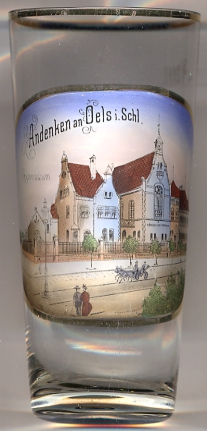

|
| POLSKA | POLAND |
| województwo: Dolnośląskie | voivodship: Lower Silesia |
| powiat: Oleśnica | county: Oleśnica |
 Oleśnica (in German: Oels) is situated at an elevation of 150 m in the northeast of Lower Silesia in southwest Poland, where the
Silesian Lowlands meet the Trzebnickie Hills, about 30 km northeast of the voivodship's capital, Wrocław.
Oleśnica is the capital of the county of the same name (powiat Oleśnicki). The municipality has a population of about 37,000 (2020).
Oleśnica (in German: Oels) is situated at an elevation of 150 m in the northeast of Lower Silesia in southwest Poland, where the
Silesian Lowlands meet the Trzebnickie Hills, about 30 km northeast of the voivodship's capital, Wrocław.
Oleśnica is the capital of the county of the same name (powiat Oleśnicki). The municipality has a population of about 37,000 (2020).
The Piast castle with a nearby abbey and trading settlement was first mentioned in a 1189 deed. From the 13th century
onwards, the area was largely settled by Germans. Since 1312 the town was the residence town of the duchy of Oels
(Oleśnica). The duchy, a Bohemian fief since 1327, was ruled from the town until the 1492 death of Duke Konrad X
the White, last of the local Piasts. The duchy was sold to Duke Henry I of Münsterberg (Ziębice),
son of the Bohemian king George of Poděbrady.
When the Podiebrad family became extinct in 1647, town and duchy were inherited by the
Swabian dukes of Württemberg, and in 1792 by the Welf dukes of Braunschweig-Lüneburg. Oels was annexed by the Kingdom of Prussia in 1742 during the First Silesian
War (1740–1742) and administered within the Province of Silesia. Following administrative reform in 1807 during the Napoleonic Wars, Oels became the seat of Landkreis Oels.
The city became part of the German Empire in 1871 during the Prussian-led unification of Germany. After World War I, Oels was included within the Province of Lower Silesia. It was
heavily damaged by the Red Army in 1945 during World War II, having approximately
[https://de.wikipedia.org/wiki/Oleśnica, https://en.wikipedia.org/wiki/Oleśnica]
The  Oelser Gymnasium [left], also named Gymnasium illustre Oels or Herzogliches Gymnasium Oels (Ducal Gymnasium Oels), from 1886
Königliches Gymnasium Oels (Royal Gymnasium Oels), was an academic school (Gymnasium), comparable to British grammar schools, sixth form colleges and U.S. preparatory high schools.
Founded in 1594, tt was the third school of this type in Silesia after the Elisabet-Gymnasium in Breslau (Wrocław, 1563) and the Gynasium in
Brieg (Brzeg, 1569). It was followed only in 1643 by the Maria-Magdalenen-Gymnasium in Breslau and in 1708 by the Ritterakademie of Liegnitz (Legnica).
The picture on glass no. 2865 shows the last school building, built in 1903. A famous student of the school was the German novelist and playwright Gustav Freitag (1816–1895).
Oelser Gymnasium [left], also named Gymnasium illustre Oels or Herzogliches Gymnasium Oels (Ducal Gymnasium Oels), from 1886
Königliches Gymnasium Oels (Royal Gymnasium Oels), was an academic school (Gymnasium), comparable to British grammar schools, sixth form colleges and U.S. preparatory high schools.
Founded in 1594, tt was the third school of this type in Silesia after the Elisabet-Gymnasium in Breslau (Wrocław, 1563) and the Gynasium in
Brieg (Brzeg, 1569). It was followed only in 1643 by the Maria-Magdalenen-Gymnasium in Breslau and in 1708 by the Ritterakademie of Liegnitz (Legnica).
The picture on glass no. 2865 shows the last school building, built in 1903. A famous student of the school was the German novelist and playwright Gustav Freitag (1816–1895).
[https://de.wikipedia.org/wiki/Oelser_Gymnasium, https://en.wikipedia.org/wiki/Gymnasium_(school)]
The Czech name of Oleśnica, Olešnice, is also used in Czech for the German towns of
Oelsnitz / Erzgeb. and Oelsnitz (Vogtl).
![[scale]](lineal.jpg)